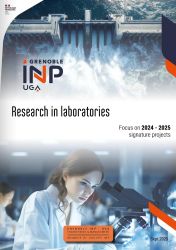By 2030, information and communication technologies (ICT) will account for 21% of global energy demand, compared with just 8% in 2015. The CIMITRANS project aims to develop new "electronic components for a sustainable digital transition". To be exact, the project focuses on millimetre-wave circuits, which are dedicated to high-frequency communication applications such as 6G, automotive radars, certain sensors in the health sector, and very high-speed communications in data centres, where energy consumption is explodin
Two new components
One of the aims of the project is to reduce the energy consumption of circuits designed for these applications by developing energy-efficient components for very high-speed communication. “The idea is to develop a broadband amplifier, one of the essential building blocks of data centres, capable of transmitting more data at equivalent power consumption", explains Sylvain Bourdel, a researcher at TIMA and the project leader. “Our aim is to increase the bandwidth by a decade for a given energy source, in order to reduce communication times by the same amount.” Interestingly, the consumption of electronic components has been divided by 100 in the last 20 years, but the actual energy consumption of electronic devices continues to explode due to changing uses.
The second aim of the CIMITRANS project is to develop more sustainable and versatile basic electronic components. “Here, the challenge is to develop test and reconfigurability techniques, which are key to reducing the number of components required in a circuit. We can also increase their lifespan by adjusting their performance as required or as they age. Artificial intelligence algorithms are used to determine the optimum parameters for operation.” The funding obtained through France 2030 will allow the team to recruit several PhD students in these fields from September 2024.
*CNRS, Grenoble INP – UGA, UGA




